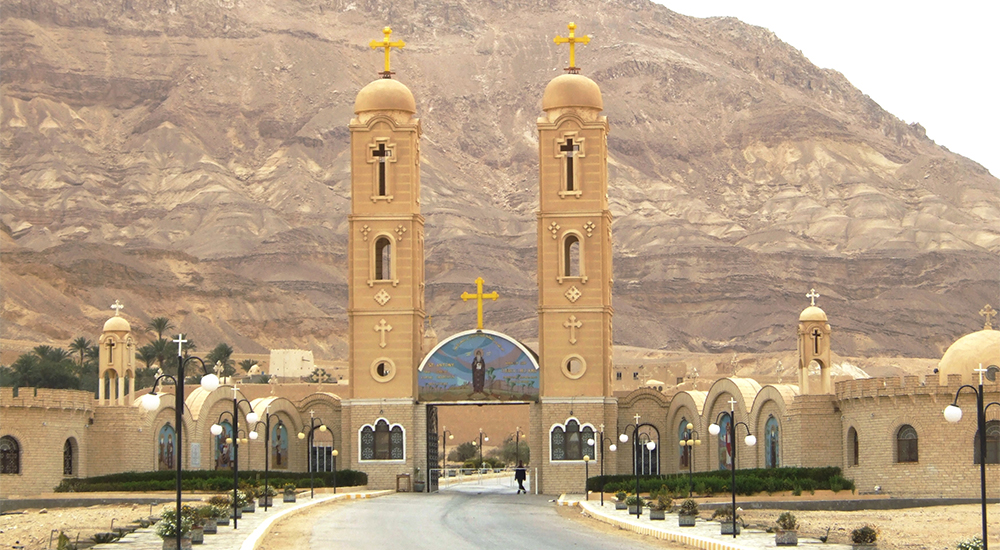A Tradition of Centuries
Joining the Trappists means becoming part of a family. The history of the Trappists stretches back sixteen hundred years. In the wind-swept deserts of fourth-century Egypt, on sunny hills in sixth-century Italy and in grassy meadows of Medieval France, monks and nuns have prayed, studied and worked together in joy and peace offering the world a glimpse of life in eternity.
The Start of Christian Monastic Life
Forms of monastic life have been part of human existence very early on. In India, China, Tibet and Japan, individuals intensely devoted to their religious beliefs separated themselves from towns and led very disciplined lives.
About a century before Christ was born there was a Jewish sect called the “Essenes” whose lifestyle might be described as monastic and who influenced John the Baptist and other disciples of Jesus. Ever since his time on Earth, Jesus has inspired people to show their love for Him by imitating the way he lived in poverty and chastity.
Forms of monastic life have been part of human existence very early on. In India, China, Tibet and Japan, individuals intensely devoted to their religious beliefs separated themselves from towns and led very disciplined lives.
Christian monastic life, as we know it today, first appeared in about 271 A.D. with the sudden conversion of St. Antony in a church in lower Egypt. Inspired by a passage from Matthew to be anxious about nothing and sell everything he possessed to follow Christ, Antony lived alone, dedicating himself to prayer and manual work. Others had done this before, but Antony, over the course of his nearly hundred-year life, inspired a movement which resulted in thousands establishing themselves as monks in the deserts of Egypt.

For the first 120 years or so, after Antony’s fame began to spread, the fathers and mothers of the desert lived alone or in small groups. Their lives were marked by extreme austerity which required remarkable psychological and physical strength.
Monks Seek Common Life
In the fourth century monks began gathering together in communities, sometimes comprising hundreds of individuals. The person who first gathered monks into large, organized communities was St. Pachomius,(286-346).
This “common life” is also called cenobitic monasticism. After living as a hermit for a while, this holy monk was called by God to be the father of several large monasteries housing hundreds of monks. His followers embraced chastity and poverty and also obedience—not that of a single monk to his “Abba” or spiritual father, but to the head of a community and to other community members.
This was a new form of obedience and became the pattern in monasteries for many centuries afterward. Unlike hermits, the monks prayed together and also worked in cooperation with one another. Monasteries became so huge they were like small towns with monks divided into “houses” of thirty or forty monks, grouped according to their skills as tailors, bakers, gardeners, etc.
The success of Pachomius’ monasteries caused the movement to spread outside Egypt to Palestine and Syria.
Reforms Reshape Monasticism
When a movement like monasticism survives for centuries, it needs to be periodically renewed in order for monks and nuns to sustain their fervor. Notably, the sixth-century Rule of St. Benedict emerged as a document guiding the pursuit of holy life.
During a time of renewal in the middle of the 10th century, the great Benedictine Abbey of Cluny (founded in 910) grew and established new monasteries all over Europe. Over time, the monasteries of Cluny became very large and prosperous, and the lifestyle of the monks became more complex and perhaps a little more comfortable too.
Gradually, some monks, like the famous St. Peter Damian, complained about the change they saw happening in monasteries. These reformers thought that the life of monks should be simpler, poorer and more closely patterned after the life of the first Christians in Jerusalem. In particular, they dreamed of a life where monks shared everything in common and could celebrate Eucharist with intense joy and faith.
Finally, in 1098, a group of monks from Molesme, which had been founded by Cluny, separated to begin their own monastery at a place called “Citeaux.” This first Cistercian monastery, over time, became an order of many monasteries.
The Cistercian Order is Defined
Most religious orders in the Catholic church were founded by one inspired person. The Cistercian Order is unusual, because it was founded by a community of three, (accompanied by several others): St. Robert, St. Alberic and St. Stephen.
Each Cistercian monk and nun carries in their heart the memory that our order was born as a community. The common life has always been the essence of who we are. Even so, our founders had very different and distinctive personalities.
Robert was a passionate and restless monk. During the course of his monastic life, he moved several times from one place to another, always dissatisfied with the way he was living the monastic ideal. Not long after he founded Citeaux, he was called back to serve as abbot of Molesme and this caused deep consternation in the small band of monks struggling to establish the new monastery.
St. Alberic succeeded Robert as abbot of Citeaux and it was he who decided the Cistercians should wear the white habit under a black scapular fastened with a leather belt, which we still wear today.
 St. Alberic died in 1109 and St. Stephen was elected abbot. St. Stephen had an extraordinary gift for organization. Assuming responsibility for a tiny and fragile monastery he transformed it in the course of several years into the first “order” in monastic history. He accomplished this by introducing the “The Charter of Charity” to be entered into by all the new monasteries founded by Citeaux.
St. Alberic died in 1109 and St. Stephen was elected abbot. St. Stephen had an extraordinary gift for organization. Assuming responsibility for a tiny and fragile monastery he transformed it in the course of several years into the first “order” in monastic history. He accomplished this by introducing the “The Charter of Charity” to be entered into by all the new monasteries founded by Citeaux.
This Charter allowed each Cistercian monastery to remain independent of the others and yet strongly united to them by legal structures and a bond of charity shown by mutual support. St. Stephen’s fervor and personality attracted many new disciples.
In the year 1112 a young man, Bernard from Burgundy, entered the new monastery and brought with him about thirty friends and relatives! St. Bernard is honored today as the spiritual father of the Cistercian Order and his arrival at Citeaux marked the beginning of a “golden age.”
Inspired by the Desert Fathers and Mothers
The Cistercian founders were inspired by the example of the desert fathers and mothers of Egypt. They believed that by “being poor with the poor Christ,” distancing themselves from the busyness of the world’s affairs and keeping their life very simple, it would be easier to pray and grow in friendship with God in Jesus.
The Trappist way of life was—and continues to be—appealing to people who hunger for a more intimate relationship with God.
Compared to their brothers and sisters in other orders, Cistercians had a simpler diet, used simpler and poorer liturgical vestments and vessels, and did not introduce stained glass windows into their churches. They reintroduced several hours of manual labor each day. And in general, they observed a stricter enclosure and had less interaction with their neighbors outside the monastery.
In the 12th century, hundreds of Benedictine monasteries were all under the authority of the one great Abbey of Cluny. In the Cistercian order, each monastery was independent but lent support to other Cistercian monasteries in keeping with The Charter of Charity.
The Name Trappist Takes Hold
The Name Trappist Takes Hold. Our common name, “Trappist” or “Trappistine” is derived from La Grande Trappe, a Cistercian monastery in the French province of Normandy where further reforms to our order began in the middle of the 17th century.
The name “Trappist” is derived from 17th century reforms that took place in a French abbey called La Grande Trappe.
In 1637, a precocious 11-year-old boy inherited from his family the honorary title of “Abbot of La Trappe.” Decades later, he decided to renounce his wealth and become a monk. He eventually led the reform movement whose promoters were nicknamed Trappists.
When Napoleon’s army invaded Switzerland in 1798, Trappists and Trappistines living there set out looking for a place of refuge. It was from this group of Trappists and Trappistines, either directly or indirectly, that Cistercian monastic life came to the United States in the nineteenth century.